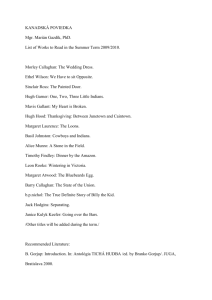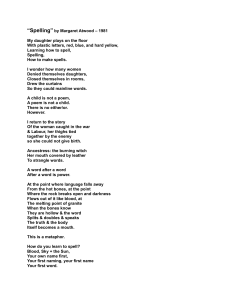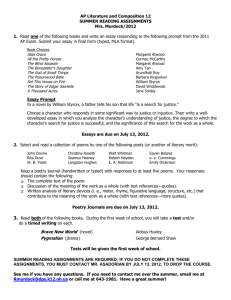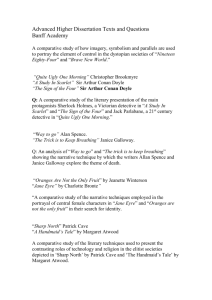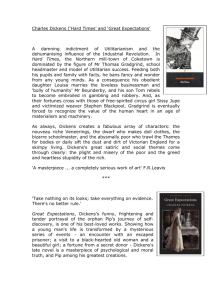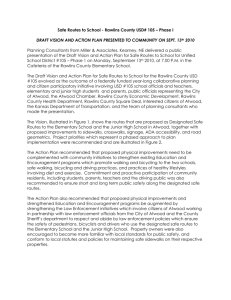3117PDF - Research Chronicler
advertisement
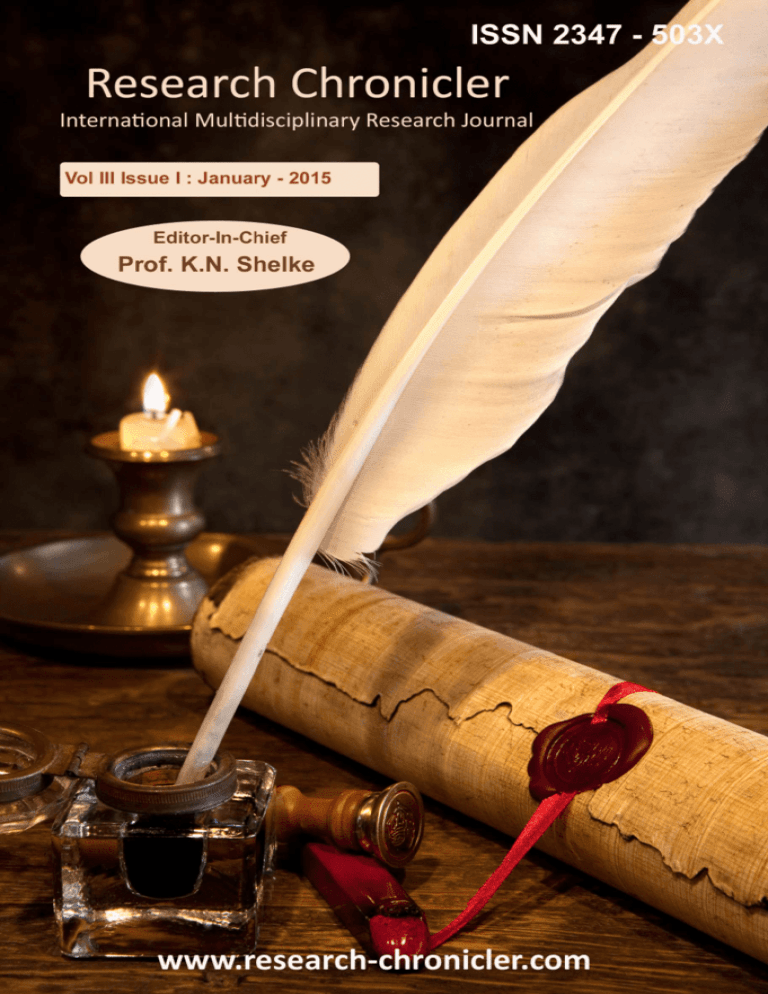
www.rersearch-chronicler.com Research Chronicler International Multidisciplinary Research journal ISSN-2347-503X Research Chronicler A Peer-Reviewed Refereed and Indexed International Multidisciplinary Research Journal Volume III Issue I: January – 2015 CONTENTS Sr. No. 1 2 3 Author Prakash Chandra Pradhan Dr. Shivaji Sargar & Moushmi Thombare Dr. Anuradha Nongmaithem 4 A. Anbuselvi 5 Deepanjali Mishra 6 Dr. Pooja Singh, Dr. Archana Durgesh & Ms. Tusharkana Majumdar Vasanthi Vasireddy 7 8 9 10 11 12 13 14 Title of the Paper Download Political Context of V.S. Naipaul’s Early 3101PDF Novels: Identity Crisis, Marginalization and Cultural Predicament in The Mystic Masseur, The Suffrage of Elvira and The Mimic Men The Ecofeminist Approach in Alice Walker’s 3102PDF The colour Purple Re-Reading of Shange’s for colored girls 3103PDF who have considered suicide when the rainbow is enuf Dysfunctional family and Marriages in Anne 3104PDF Tyler’s Novel Impact of Sociolinguistics in Technical 3105PDF Education Girl, Boy or Both: My Sexuality, My Choice 3106PDF Akhila’s Escape to Kanyakumari – a Travel in Search of ‘Self’ Dr. Laxman Babasaheb Social Consciousness in Early Dalit Short Patil Stories Sushree Sanghamitra Corporate Governance Codes in India- A Badjena Critical Legal Analysis Dr. Ashok D. Wagh The Role of Budgeting in Enhancing Genuineness and Reliability in Financial Administration in Colleges of Thane District Sushila Vijaykumar Consciousness-Raising in Thirst L.X. Polin Hazarika Influence of Society on Assamese Poetry Dr. Archana Durgesh & Reading Women and Colonization: Revenge Ajay Kumar Bajpai Sachidananda Saikia Mahesh Dattani’s ‘On a Muggy Night in Mumbai’: A Critique on Heterosexuality Volume III Issue I: January 2015 3107PDF 3108PDF 3109PDF 3110PDF 3111PDF 3112PDF 3113PDF 3114PDF Editor-In-Chief: Prof. K.N. Shelke www.rersearch-chronicler.com Research Chronicler International Multidisciplinary Research journal 15 Nandini Sharma Dr. V. Premlata 16 Mr. Suresh D. Sutar 17 Goutam Karmakar 18 Dr. Ambreen Safder Kharbe 19 Dr. Raja Ram Singh 1 1 & Theatre and Phenomenology: Beckett’s Waiting for Godot within the Apparatus of Merleau Ponty’s Phenomenology of Perception Ted Hughes’ Crow’s First Lesson: An Ecocritical Study A Study of Margaret Atwood and Her Poetic World Havoc of Western Culture on Indian Immigrants: A Study of Manju Kapur’s The Immigrant Ethnic Identity of Bagri caste: A Sociological Analysis Hossein Sheikhzadeh Dr. Chandra Sharma ISSN-2347-503X Bāgādh, the Lizard - A Balochi Story Shekhar On the 30th Anniversary of Bhopal Gas Tragedy Volume III Issue I: January 2015 3115PDF 3116PDF 3117PDF 3118PDF 3119PDF 3120PDF 3121PDF Editor-In-Chief: Prof. K.N. Shelke www.rersearch-chronicler.com Research Chronicler ISSN-2347-503X International Multidisciplinary Research journal A Study of Margaret Atwood and Her Poetic World Goutam Karmakar Assistant Teacher, Department of English, Bhagilata High School (H.S), Raiganj, Uttar Dinajpur, (West Bengal) India Abstract Atwood‟s poetry on a level focuses on the question of identity with as much fashion as Neruda and Walcott did in their works. In her works, we find her capability in playing with word and language. A recessive reading of her poetry can highlight these further. Atwood actually before a novelist, considered himself first as a poet. In her life a spiritual and mental growth are found as her journey from innocence from experience came after her confrontation with Canadian Wilderness, middleclass norms, ideals of Christianity and stark materialism of North American Society. And she shows a journey through a spiritual wasteland before they can reach maturity. In this paper I have attempted to show her poetic world as well as different themes, symbols and motifs through some of his well known verse. Key Words: Identity, Vision, Imagery, Language, Symbolism. Introduction: Margaret Atwood has deeply involved with nationalism and the rise of independent cultural values in Canada. Although she has spent a lot of time in America but she has never thought herself as an American poet. She is a poetess with different attitude. She shows the status, position and life of woman but she never wants to call herself a feminist poet. Actually she is a passionate observer of Canadian life and shows man-woman relationship, sense of alienation, civilization vs. wilderness, mortality, savage land and identity crisis in her poetry. And to express all these, she needs constant change into other forms to attain what she desires. deceptive ordinariness of daily life and the continuous problems that we receive due to technology. In her „The Animals in That Country (1968)‟,we find poetry of conflict and contrasts between familiar and unknown, civilization and wilderness, man and animals. In her „The Journals of Susan Moodie (1970)‟, she took a peculiar way to show Canadian history as she here told us everything from the viewpoint of famous pioneer woman, Susanna Strickland Moodie. Here she wanted to show Canadian identity, brutality of civilization, awe of the landscape, forest and uprising terror with a difference between sinister and picturesque. In her „Procedures for Underground‟ (1970), she dealt with haunted past, fear of death, oblivion and loss. In her „Power Politics‟ (1971), she showed her feministic If we look at her collection of poems then we find a gradual change of theme in her poetry. In her „The Circle Game‟ (1966) she wanted to show the Volume III Issue I: January 2015 (132) Editor-In-Chief: Prof. K.N. Shelke www.rersearch-chronicler.com Research Chronicler ISSN-2347-503X International Multidisciplinary Research journal attitude and suffering, bitter treatment and subjugation of woman. In „You Are Happy‟ (1974), she wanted to overcome her suffering, despair and wanted to seek happiness and fulfillment in life. In „Two-Headed Poems‟ (1978), she dealt with female body, heart, bloodiest incidents in Canadian history. In her „True Stories‟ (1981), she raised the issue of political oppression and environmental devastation. So in these volumes, she dealt with various themes and issues. Discussion of some of her poems will clear this very well. to retain the ownership of earth, the inherent folly behind the notion of ownership and finally shows the reason the reason for man‟s inability to capture earth. Only Mother Nature with her animate and inanimate object will continue to live and dictate terms. Actually a deconstructive reading shows that it is a poem which appeals to the environmental activism, the history of Canada and European imperialism. As she says: “You own nothing you were a visitor, time after time climbing the hill, planting the flag, proclaiming We never belonged to you. You never found us. It was always the other way round.” (The Moment) Atwood in some poems raises issues and problems regarding child depression to show greater problems. In her „A Sad Child‟, she wants to show us the pathetic condition of child who takes pills in sadness and out of depression. Sadness is also needed in life so that we can appreciate the happiness and it is also shown. Also she wants to show sadness as a part of life and not as a tragedy and one has to move on in spite of all these. She seems to offer a somewhat disquieting source of comfort to an otherwise unfair world ruled by favoritism and sadness. As she says: Atwood‟s poetic world also consists of myths and allusions. And it is shown in her „Siren Song‟, a very clever, concise and darkly facetious poem. Here the speaker is one of the three sirens which allude to Greek mythology. She here changes the point of view in her revision of the Siren song and examines a side of the story that has never been explored before. It is a poetry that criticizes men who are greedy, not so smart and fade in comparison to the woman‟s mind. Here also the obvious bias in characterization put on woman now is changed as here men are trapped. She says thus: “You‟re sad because you‟re sad It‟s psychic. It‟s the age, It‟s chemical go see a shrink or take a pill or hug your sadness like an eyeless doll You need to sleep.” (A Sad Child) “This is the one song everyone would like to learn: the song that is irresistible: the song that forces men to leap overboard an squadrons Contemporary society, feministic and didactic attitude are also part of Atwood‟s poetic world. In „The Moment‟, she shows how man‟s claim Volume III Issue I: January 2015 (133) Editor-In-Chief: Prof. K.N. Shelke www.rersearch-chronicler.com Research Chronicler ISSN-2347-503X International Multidisciplinary Research journal even though they see beached skulls.” (Siren Song) childish, resentful tone and says that she would be bored with nothing significant to do and linger in the shadow of her father. But now she feels that she thinks foolishly that time and wants to go to that workless world again. As a postmodern writer, she also makes satirical impersonations of modernist writers. Actually she wants to tell us that we should find joy in small things also. As she says: Atwood‟s poetic world is also full of imagery, symbols as she uses a variety of literary devices to explain her poems. One such is „Flying Inside Your Own Body‟. Here she uses imagery of lungs filling and spreading themselves like „wings of pink blood‟. Here the wings are the symbol of freedom. The bones are hollow and represent the outline of human body. A close reading of the poem shows that one can only be free and have happiness in her sub consciousness. But after weakening, one is sure to be subdued by the pain, sorrow and harsh reality of life. As she says: “I could hardly wait to get the hell out of there to anywhere else. Perhaps though boredom is happier. It is for dogs or groundhogs. Now I wouldn‟t be bored. Now I would know too much Now I would know.” (Bored) “ The Sun‟s a hot copper weight pressing straight down on the think pink rind of your skull. It‟s always the moment just before gunshot. You try and try to rise but you cannot.” (Flying Inside Your Own Body) Atwood illustrates a remarkable determination and strong will to face death which is a recurring theme in many poems like „Another Elegy‟, Marrying the Hangman‟, „Time‟, „Bedside‟, „Flowers‟ and „Morning in the burned house‟. In „Morning in the burned house‟, she says that nothing remains here as everything has been damaged by fire and smoke. As she says: In her career, she often talks about love and the need of it. As in „February‟, she talks about her negative experience with that particular month. As February is a month associated with love and she has no one to share her love. But the concluding lines show her optimism as she has set out her journey to find her love. As she says: “No one else is around where have they gone to, brother and sister, mother and father?” (Morning in the burned house) In „Flowers‟, the speaker feels pity and sad for her dying father. The speaker realizes that one day she will also die as man is mortal and death is common to all. As she says in the concluding lines: “You‟re the life principle more or less, so get going on a little optimism around here Get rid of death. Celebrate increase. Make it be spring.” (February) “…even the memory of how I brought them from a garden, I will no longer have by then, Pat memories also haunt her and gave her pain. In „Bored‟, she adopts a Volume III Issue I: January 2015 (134) Editor-In-Chief: Prof. K.N. Shelke www.rersearch-chronicler.com Research Chronicler ISSN-2347-503X International Multidisciplinary Research journal And put them beside my dying father Hoping I could still save him.” (Flowers) here. Love comes in waves like the ocean, a sickness which goes on and on, a hollow cave in the head, filling and pounding, a kicked ear.” (Postcards) Feminism is also present in her poetic world or cosmos. In „Helen of Troy Does Countertop Dancing‟, she shows that woman‟s beauty and sexuality at one level control and dominate man‟s desirability and on another level, it makes her into object in the eyes of men. So the poem raises a question about how women should perceive their sexuality and whether it is a source of power or something hidden. The concluding lines what men miss and what they do in order to think a woman in his way: Atwood‟s poetic thought sometimes captures several issues in one single poem. As in „You Begin‟, the world, our views of it, freedom, limitation, perception, bias all issues are present. We restlessly attempt to understand the world and paradoxically comprehend the incomprehensible. But with the growth of age, men learn. Here Atwood shows her mastery over words and their uses as she uses the word „hand‟ metaphorically: “I hover six inches in the air in my blazing swan-egg of light. You think I‟m not a goddess? Try me. This is a torch song. Touch me and you‟ll burn.” (Helen of Troy Does Countertop Dancing) “The word hand floats above your hand like a small cloud over a lake The word hand anchors Your hand to this table Your hand is a warm stone I hold between two words.” (You Begin) Atwood also comments on love in her poetry and judges it with reality and truth behind it. In her „Postcards‟, she shows many things through the elements of love. The pictures on the postcard are inappropriate representations of reality as they are merely delusions. The last few lines show that the emptiness and hollowness in the postcard and love. A deconstructive reading however show that here Atwood experiments to conflate between internal and external landscape and also the painful reality of love. As she says: In her „This is a Photograph of Me‟, she shows feminism with identity crisis. In patriarchy, males are creating woman‟s stories. Like the blurred photograph, a woman‟s contribution to society is shadowed. It is also a poem about Canadians who tend to remain in the background and have centrist politics. But the poet does not want to historicize the time of woman‟s exploitation. As she says: “but if you look long enough eventually you will see me.” (This is a Photograph of Me) “Turn you over, there‟s the place for the address. Wish you were Volume III Issue I: January 2015 Search for identity, quest and warning are found in her „Procedures for (135) Editor-In-Chief: Prof. K.N. Shelke www.rersearch-chronicler.com Research Chronicler ISSN-2347-503X International Multidisciplinary Research journal Underground‟. In this poem, she issues a dire warning to those who are listening to her as she talks about the country beneath the earth. Underground here may be considered as Hell but Atwood conjures up the procedures a person may adopt to go there for the knowledge of human consciousness. Here a deconstructive reading shows that the journey is about the search for human identity. And she says that traveling to the underworld may not be a simple victory, for the traveler is cautioned: and are gone Their deaths are not elegant They have the faces of No-one…” (The Animals in That Country) Atwood in her poetry makes a lot of comparisons. In her „In the Secular Night‟, she shows her anger and regret for not escaping from the imprisonment of the strong loneliness. She has also compares childhood life with present life. Actually she wants to show that people who are in a great depression often lose their principles and belief. And ultimately they pull themselves further away from their faith and expectation from God is almost vanished. Here she also plays with words, languages as aphorism is also shown here: “You will find those who were once your friends but they will be changed and dangerous.” (Procedures for Underground) “There is so much silence between the words, You say. You say, The sensed absence Of God and the sensed presence Amount to much the same thing, Only in reverse.” (In the Secular Night) Atwood in some of her poems like „The Animals in That Country‟ also reveals the ugly deeds of her country men and his ancestors. She refers to the people of England who established their colony in Canada, a place where oppression has been rampant for years. They haunted the natives like sly, predatory animals. Now these people are in power in Canada and engage in the bloody sport of provoking and then killing animals to provide immense joy. Actually Atwood does not want to forgive the colonizers who have destroyed her country‟s civilization and thus thrust the so called modern civilization on the natives. As the concluding lines show that the natives have no identity of their own: Atwood is humorous also as it is shown in „The Landlady‟. Here she also plays with words like the bossy landlady‟s slamming the doors about the house which tantamount to slamming the lodger‟s days, the days she would have spent in productive work. Search for identity is also here as it is often difficult to recognize or accept what one already is. Here are the lines which show her mastery over words with satirical humour: “In this country the animals have the faces of animals. Their eyes flash once in car headlights Volume III Issue I: January 2015 “Over a vast face which is the landlady‟s. . . . (136) Editor-In-Chief: Prof. K.N. Shelke www.rersearch-chronicler.com Research Chronicler ISSN-2347-503X International Multidisciplinary Research journal “There is nothing to be afraid of it is only the wind changing to the east, it is only your father the thunder your mother the rain.” (Night Poem) She stands there, a raucous fact Blocking my way. Immutable a slab Of what is real, Solid as bacon.” (The Landlady) Her „Spelling‟ is a poem which shows how language and image reveals and conceals the problems and issues for feminist discourse. With apparent subjectivity, imperialism in the form of man‟s sexual domination, feminist ideals, sexual identity with cultural politics she gives a new outlook and thought in this poetry. She even personified language here: Conclusion: So in the concluding lines it can be said that Atwood presents various voices, cultures, issues, images and symbols that make up the grand mix of American identity and she is descended from the settler‟s who made the New World possible. Atwood focuses on social and psychological questions of contemporary life, but still she manages to provide the mythic and cultural resonance. What she believes is that a poet raises voice in a continuous way from a private and cultural consciousness. And it is difficult to distinguish Atwood as a poet or novelist or publicist because we have created various Atwood in our imagination to satisfy our cultural needs. Actually she is a feminist, satirist, mythological poet, nationalist and formulator of critical theories. “the word splits and doubles & speaks the truth the truth and the body itself becomes a mouth.” (Spelling) Atwood in his poetry in a very skillful way shows Nature and parents in a peculiar and parallel way. In her „Night Poem‟, she shows how Nature continuously protects our lives and relates real aspects of life to the parts of nature. Weather is here shown in parental figures. As the opening lines show: References: 1. Atwood, Margaret. (1976). Selected Poems 1965-1975. New Work : Houghton Mifflin Company. 2. Atwood, Margaret (1987). Selected Poems II: 1976-1986 (Vol 2). New Work : Houghton Mifflin Company. 3. Atwood, Margaret. (1995).Morning in the Burned House: New Poems. New Work : Houghton Mifflin Company. 4. Mendez-Eagle, B. (ed.). (1987) Margaret Atwood: Reflection and Reality. Edinburg: Pan American University Press. 5. Nicholson, Colin, (ed.) .(1994). Margaret Atwood: Writing and Subjectivity. New York : St. Martin‟s Press Volume III Issue I: January 2015 (137) Editor-In-Chief: Prof. K.N. Shelke www.rersearch-chronicler.com Research Chronicler ISSN-2347-503X International Multidisciplinary Research journal 6. Grace, Sherril E. and Lorraine Weir, eds. (1983). Margaret Atwood: Language, Text and System. Vancouver: University of British Colombia Press. 7. Batra, Shakti. (2008). Three Contemporary Poets (A Critical Study), Surjeet Publications. 8. Sparknotes Editons. (2006). “Sparknotes on Margaret Atwood‟s Poetry‟, Spark notes.com ,Spark note LLc. Retrived on December 12,2014 http://m.sparknotes.com/poetry/atwood Volume III Issue I: January 2015 (138) Editor-In-Chief: Prof. K.N. Shelke
